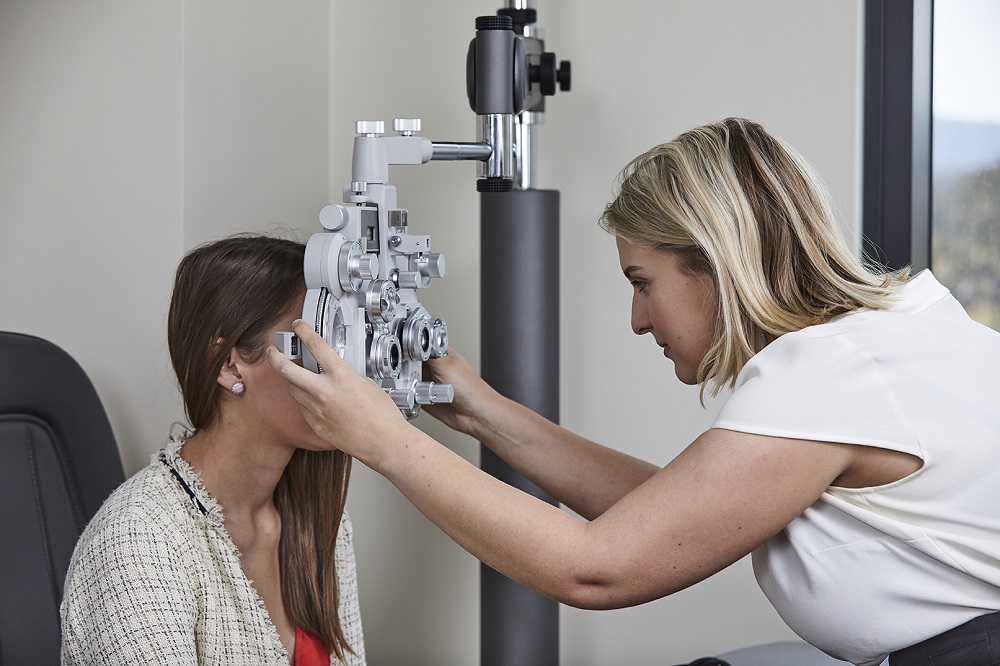Suzanne Lazaroo
23 September 2020: People with eye problems or chronic visual conditions like glaucoma are benefiting from a University of Canberra and Canberra Hospital collaboration to get the care they need, when they need it, without going to hospital.
The University’s state-of-the-art Optometry Clinic has been taking referrals from the Canberra Hospital for the more ‘regular’ types of clinical conditions and to manage patients who may require repeat visits or follow-up visits.
As one of the UC Health Clinics, the Optometry Clinic has the dual focus of equipping the next generation of optometrists with on-the-job skills and experience, while providing the Canberra community with high quality health services at an affordable cost.
The collaboration with The Canberra Hospital is overseen by Dr Nick Brown, Director of the University of Canberra Clinical School.
The clinic forms a bridge between practitioners of ophthalmology and optometry, so that patients’ conditions can be managed in a cooperative fashion.

Canberra Health Services’ Dr Andrew Mitchell, Director of Territory-wide Surgical Services, says that the collaboration is based on a synergy of purpose – to ensure better community eye health, which includes mitigating risk – and has been hugely beneficial to patients.
“The Canberra Hospital’s clinic is configured for surgery and acute care, rather than treating patients with more ‘regular’ eye problems or chronic conditions like glaucoma,” Dr Mitchell said. “This collaboration helps to treat patients who present with these kinds of problems more quickly.”
“This joint approach also helps with eye health monitoring, or where patients need repeat visits or follow-ups, by easing the demand for more common eye problems at Canberra Hospital,” Dr Mitchell says.
Clinical Assistant Professor Dr Faran Sabeti has seen many of the referrals in question, and says there is great satisfaction in being able to lift the burden that people with poor eye health often shoulder.
“Chronic eye conditions like glaucoma require a lot of monitoring, and this can be completed under the care of an optometrist in collaboration with an ophthalmologist,” Dr Sabeti said.
The clinic is currently overseen by Lead Clinical Educator and Clinic Manager Tina Jong, herself an optometrist for eight years. In the latter half of 2021, it will be taken over by Master of Optometry students under supervision.
“We are glad that our health clinic can assist the public health system in this way, alleviating some of the strain on it,” Ms Jong said.
“Some of the most recent referrals that I have seen have been on a waiting list for consultation. A condition such as dry eyes can be debilitating for the patient, but because it’s not considered a sight- or life-threatening condition, it can get pushed down the priority list.”
Ms Jong says that under the collaboration, University clinicians conduct the assessments, then consult with Canberra Hospital ophthalmologists to find a management plan for patients.
“These placements are also very valuable for students, particularly for eye examinations, as they learn the importance of managing eye care in a primary care setting with state-of-the-art technology,” she said.
“In addition to the photoropter [refractor] which we use to determine refractive error, we have a slit lamp to check eye health, and a topographer to measure the curvature of the eyeball,” Ms Jong said.
“A topographer is important because in some conditions, the eyes are cone-shaped. For people with those conditions, their eyes are susceptible to infections and breakages in the cornea. It’s also great for contact lens fittings, and corrective lenses can reshape the eye to stop the progression of myopia.”
Retinal photography equipment provides a wider, more in-depth scan of the eyes (100° to 140°); visual field machinery tests peripheral vision; and the ocular coherence tomography (OCT) machine that assesses the structure of the inner eye.
“This is particularly useful in neurological conditions and macular degeneration, because it makes it easy to see changes in nerve thickness or retinal tissue,” Ms Jong said.
“We also have a biometer – which is not commonly available in standard optometry practices – that checks the length of the eye, from front to back.
“The eyeballs of patients with myopia have grown longer, which is why they can’t focus well without correction. When your eyeball lengthens, you also run the risk of retinal detachment, glaucoma, cataracts and other retinal conditions.
“We need to control these risks, and for short-sighted patients, the biometer is the best way to check if management is working.
“If the patients are happy for us to do so, we also routinely write to their general practitioners and send them our reports – it’s good to have collaborative care and keep their doctors across what’s happening with their eye health.”
Patients with Medicare cards enjoy bulk billing. “For those without Medicare, we charge a minimal fee – and we have concession fees for students and senior citizens,” Ms Jong said.
The clinic also provides free services for refugees from community organization Companion House.
“A lot of these patients don’t have the means to afford eye care, and aren’t eligible for Medicare benefits,” Ms Jong said. “We want to make sure they are getting the assessment and treatment they need, because many refugee patients may not have had optimal eye care in their home countries.”
Patient and staff safety is always front and centre throughout the University of Canberra and during this COVID-19 pandemic, the clinic also offers telehealth consultation options. Nonetheless, the clinic has remained open throughout 2020, to cater for patients who need eye care.
All sanitising and distancing precautions are in place, with strict screening processes applied.
“We use disposable masks and are constantly cleaning surfaces,” Ms Jong said. “High levels of sanitation are standard practice in eye care anyway – the pandemic has just reinforced the importance of stringent hygiene practices.”
Click here to make an in-person or telehealth appointment at UC’s Optometry Clinic.


